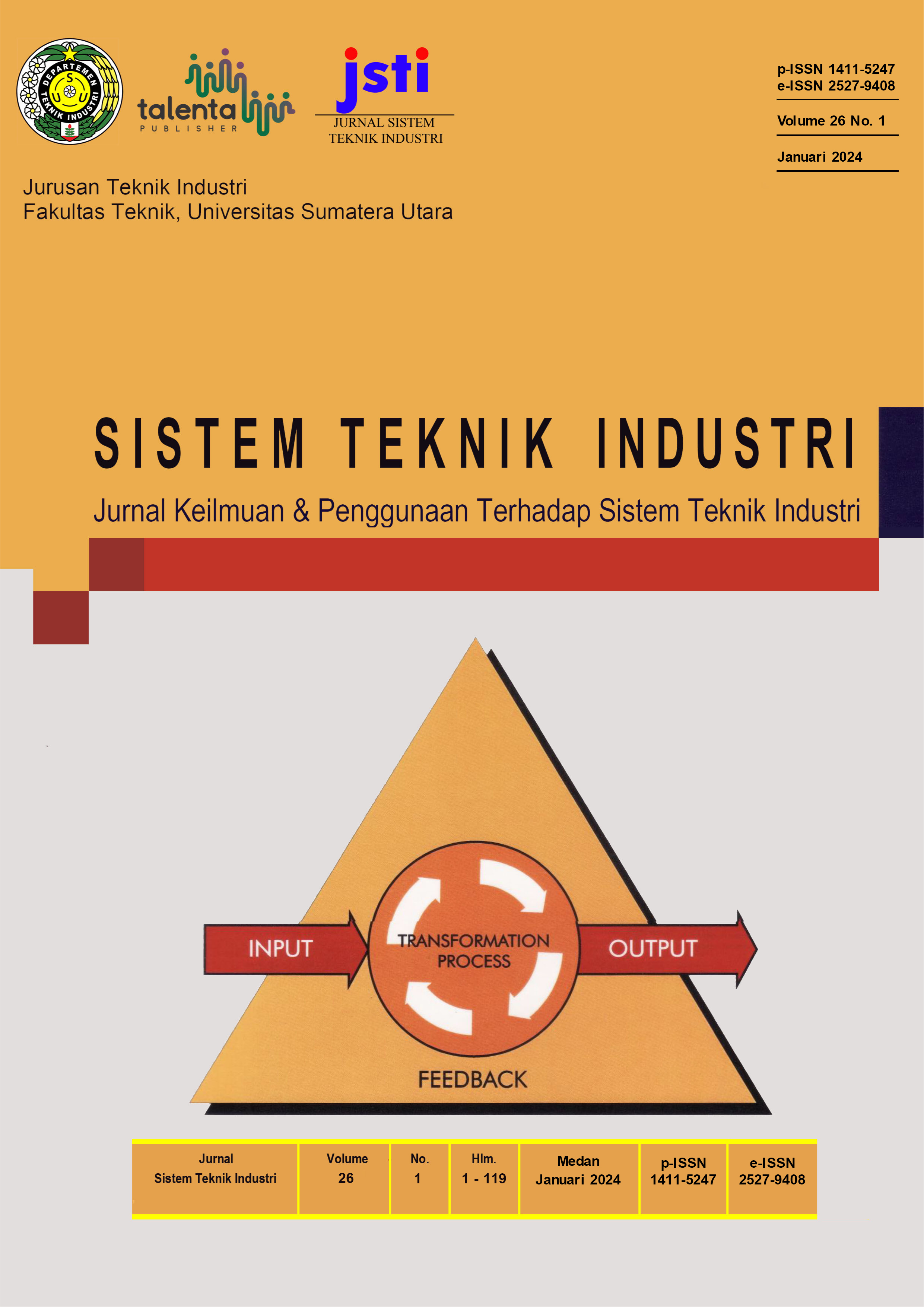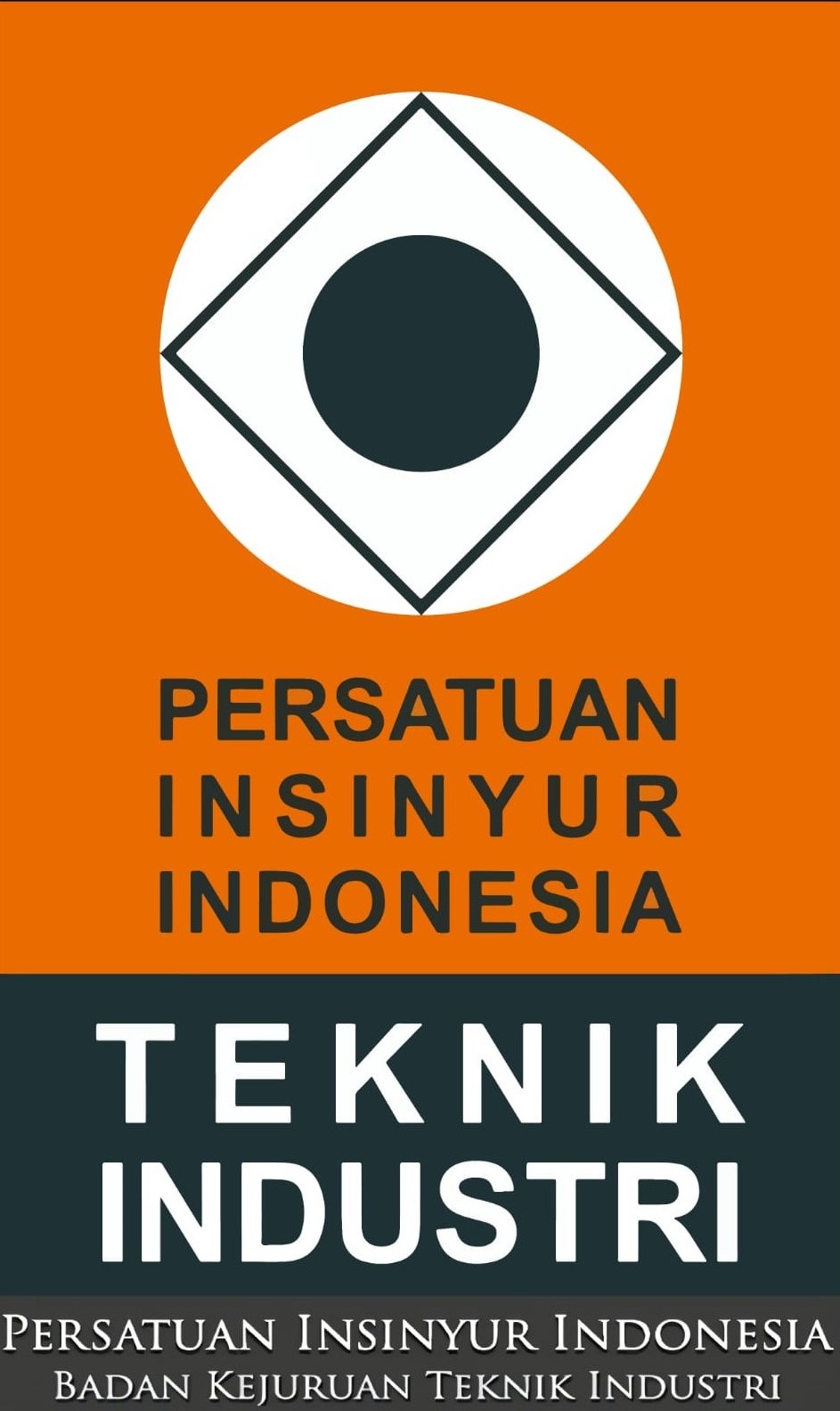Integration of Lean Six Sigma and Ergonomics in Internal Logistics in the Supply Chain – A Systematic Literature
DOI:
https://doi.org/10.32734/jsti.v26i1.13743Keywords:
Ergonomy, Lean, Logistic Internal, Six SigmaAbstract
Today's most significant challenge facing the industry is delivering good quality products quickly, at the lowest possible cost, and flexibly in meeting demand. In terms of timing accuracy, companies must have good internal logistics, one of which is good warehouse management. Productivity in warehouses can be achieved by improving efficiency in warehouse operations, thus resulting in a faster response to customer requests. In improving productivity, it is necessary first to identify unexpected activity. This study demonstrates the importance of applying Lean Six Sigma (LSS) in Supply Chain Management (SCM), particularly internal logistics in the warehouse area, by linking the ergonomics principle with the systematic literature review approach. LSS and ergonomics are mutually complementary methodologies to meet the challenges of SCM in order to have a competitive advantage in business.
Downloads
References
F. Nurprihatin, N. E. Yulita, and D. Caesaron, “Usulan Pengurangan Pemborosan Pada Proses,†Prof. Akuntan Menuju Sustain. Bus. Pract., pp. 809–818, 2017.
B. Mr. Sujay, C. Dr. Abhijit, and B. Mrs. Nabanita, “Improving Productivity Using Work Study Technique,†Int. J. Res. Eng. Appl. Sci., vol. 6, no. 11, pp. 49–55, 2016, [Online]. Available: https://euroasiapub.org/wp-content/uploads/2016/12/5EASNov-4237-1.pdf.
P. Raghuram and M. K. Arjunan, “Design framework for a lean warehouse – a case study-based approach,†Int. J. Product. Perform. Manag., vol. 71, no. 6, pp. 2410–2431, 2022, doi: 10.1108/IJPPM-12-2020-0668.
B. Baby, N. Prasanth, and S. S. Jebadurai, “Implementation of lean principles to improve the operations of a sales warehouse in the manufacturing industry,†Int. J. Technol., vol. 9, no. 1, pp. 46–54, 2018, doi: 10.14716/ijtech.v9i1.1161.
A. Faritsy Al Zaqi and Suseno, “Peningkatan produktivitas perusahaan dengan menggunakan metode,†J. Tek. Ind., vol. 10, no. 2, pp. 103–116, 2015.
K. A. Bonilla-Ramirez, P. Marcos-Palacios, J. C. Quiroz-Flores, E. D. Ramos-Palomino, and J. C. Alvarez-Merino, “Implementation of Lean Warehousing to Reduce the Level of Returns in a Distribution Company,†IEEE Int. Conf. Ind. Eng. Eng. Manag., pp. 886–890, 2019, doi: 10.1109/IEEM44572.2019.8978755.
D. Arini, L. Andrawina, and W. Juliani, “Pengurangan waste of motion pada proses layanan material sheet di gudang metal pt digantara indonesia.†2016.
T. Ristyowati, A. Muhsin, and P. P. Nurani, “MINIMASI WASTE PADA AKTIVITAS PROSES PRODUKSI DENGAN KONSEP LEAN MANUFACTURING (Studi Kasus di PT. Sport Glove Indonesia),†Opsi, vol. 10, no. 1, p. 85, 2017, doi: 10.31315/opsi.v10i1.2191.
M. Waseem, U. Ghani, T. Habib, S. Noor, and T. Khan, “Productivity Enhancement at Molding Compound Manufacturing Plant by Applying Time and Motion Analysis,†Mehran Univ. Res. J. Eng. Technol., vol. 40, no. 4, pp. 761–774, 2021, doi: 10.22581/muet1982.2104.07.
F. Aqlan, S. S. Lam, M. Testani, and S. Ramakrishnan, “Ergonomic Risk Reduction to Enhance Lean Transformation Ergonomic Risk Reduction to Enhance Lean Transformation State University of New York at Binghamton,†Proc. 2013 Ind. Syst. Eng. Res. Conf., no. November, 2013.
J. Walder, J. Karlin, and C. Kerk, “Integrated Lean Thinking and Ergonomics: Utilizing Material Handling Assist Device Solutions for a Productive Workplace,†pp. 1–20, 2007.
U. S. S. Dharmapriya and A. K. Kulatunga, “New Strategy for Warehouse Optimization – Lean warehousing,†Int. Conf. Ind. Eng. Oper. Manag., pp. 513–519, 2011.
V. Mayang, L. P. S. Hartanti, and J. Mulyono, “Identifikasi Waste pada Proses Produksi Paku Menggunakan Metode Waste Assessment Model,†Bul. Profesi Ins., vol. 5, no. 1, pp. 1–8, 2022, doi: 10.20527/bpi.v5i1.122.
L. P. S. Hartanti, J. Mulyono, and V. Mayang, “Penerapan Fmea Dan Fuzzy Fmea Dalam Penilaian Risiko Lean Waste Di Industri Manufaktur,†JST (Jurnal Sains dan Teknol., vol. 11, no. 2, pp. 293–304, 2022, doi: 10.23887/jstundiksha.v11i2.50552.
T. T. H. Tran, “Improving Warehousing process with Lean Management,†Thesis, Bachelor Bus. Adm. Helsinki Metrop. Univ., p. 52, 2015.
S. Salah, A. Rahim, and J. A. Carretero, “Implementation of Lean Six Sigma (LSS) in supply chain management (SCM): an integrated management philosophy,†Int. J. Transitions Innov. Syst., vol. 1, no. 2, p. 138, 2011, doi: 10.1504/ijtis.2011.039622.
P. I. Piay, H. J. Kristina, and C. O. Doaly, “Pengurangan Jumlah Produk Cacat Pada Produksi Glasses Box Dengan Metode Lean Six Sigma,†J. Ilm. Tek. Ind., vol. 9, no. 2, p. 81, 2021, doi: 10.24912/jitiuntar.v9i2.12654.
I. I. Irfandi, A. M. P. Patabang, and O. H. Sari, “Identifikasi Faktor Kritikal Pendukung dan Penghambat Implementasi Lean Construction pada Megaproyek di Indonesia,†Bear. J. Penelit. dan Kaji. Tek. Sipil, vol. 7, no. 3, p. 169, 2022, doi: 10.32502/jbearing.4649202273.
N. Sampouw and M. Hartono, “The Role of Ergonomics in Suporting Supply Chain Performance in Manufacturing Companies: A Literature review,†IOP Conf. Ser. Mater. Sci. Eng., vol. 703, no. 1, 2019, doi: 10.1088/1757-899X/703/1/012034.
N. P. Wardani, W. Septiani, and D. M. Safitri, “Lean Ergonomics Untuk Perbaikan Proses Assembly Core Bracket Trunion,†J. Ilm. Tek. Ind., vol. 10, no. 3, pp. 245–253, 2023, doi: 10.24912/jitiuntar.v10i3.11781.
I. L. Nunes, “Integration of Ergonomics and Lean Six Sigma. A Model Proposal,†Procedia Manuf., vol. 3, no. Ahfe, pp. 890–897, 2015, doi: 10.1016/j.promfg.2015.07.124.
C. Bianca and D. Anca, “Ergonomic Issues in Lean Manufacturing.†2016.
D. Andrian and Renilaili, “Pengukuran Tingkat Risiko Ergonomi Dengan Menggunakan Metode Ovako Working Analysis System ( OWAS ) Untuk Mengurangi Risiko Muscoleskeletal Measurement of Ergonomic Risk Levels Using the Ovako Working Analysis System ( OWAS ) Method to Reduce Muscoleskele,†Integr. Tek. Ind., vol. 6, no. 1, pp. 32–37, 2021.
R. Abdullah, W. Ariastuti, and R. Nuraini, “Pengendalian Kualitas Kemasan Wedang Uwuh di CV Progress Jogja,†Integr. J. Ilm. Tek. Ind., vol. 8, no. 1, 2023, doi: 10.32502/js.v8i1.5691.
L. Botti, C. Mora, and A. Regattieri, “Integrating ergonomics and lean manufacturing principles in a hybrid assembly line,†Comput. Ind. Eng., vol. 111, pp. 481–491, 2017, doi: 10.1016/j.cie.2017.05.011.
Z. Geraldo, L. Vieira, and G. Balbinotti, “Lean Manufacturing and Ergonomic Working Conditions in the Automotive Industry | Elsevier Enhanced Reader.†2015, [Online]. Available: https://reader.elsevier.com/reader/sd/pii/S2351978915006885?token=675FAD8AD1BBD59B254B77DC1FEED50E06328657D78BB0A82FF5848523456796EEC9946FD02D7076923E49410CDE69A7&originRegion=eu-west-1&originCreation=20220409025636.
T. Sakthi Nagaraj, R. Jeyapaul, K. E. K. Vimal, and K. Mathiyazhagan, “Integration of human factors and ergonomics into lean implementation: ergonomic-value stream map approach in the textile industry,†Prod. Plan. Control, vol. 30, no. 15, pp. 1265–1282, 2019, doi: 10.1080/09537287.2019.1612109.
I. W. R. Taifa, “A student-centred design approach for reducing musculoskeletal disorders in India through Six Sigma methodology with ergonomics concatenation,†Saf. Sci., vol. 147, no. November 2021, 2022, doi: 10.1016/j.ssci.2021.105579.
I. Abushaikha, L. Salhieh, and N. Towers, “Improving distribution and business performance through lean warehousing,†Int. J. Retail Distrib. Manag., vol. 46, no. 8, pp. 780–800, 2018, doi: 10.1108/IJRDM-03-2018-0059.
Downloads
Published
How to Cite
Issue
Section
License
Copyright (c) 2024 TALENTA Publisher Universitas Sumatera Utara

This work is licensed under a Creative Commons Attribution-ShareAlike 4.0 International License.
The Authors submitting a manuscript do so on the understanding that if accepted for publication, the copyright of the article shall be assigned to TALENTA Publisher Universitas Sumatera Utara as the publisher of the journal.
Copyright encompasses the rights to reproduce and deliver the article in all forms and media. The reproduction of any part of this journal, its storage in databases, and its transmission by any form or medium will be allowed.



















